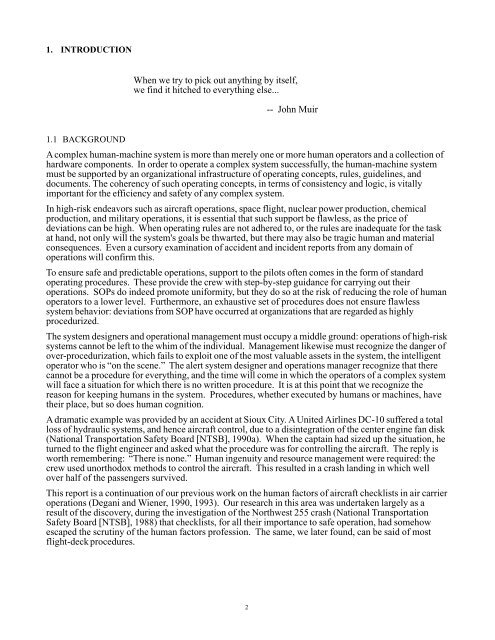On the Design of Flight-Deck Procedures - Intelligent Systems ...
On the Design of Flight-Deck Procedures - Intelligent Systems ...
On the Design of Flight-Deck Procedures - Intelligent Systems ...
You also want an ePaper? Increase the reach of your titles
YUMPU automatically turns print PDFs into web optimized ePapers that Google loves.
1. INTRODUCTIONWhen we try to pick out anything by itself,we find it hitched to everything else...-- John Muir1.1 BACKGROUNDA complex human-machine system is more than merely one or more human operators and a collection <strong>of</strong>hardware components. In order to operate a complex system successfully, <strong>the</strong> human-machine systemmust be supported by an organizational infrastructure <strong>of</strong> operating concepts, rules, guidelines, anddocuments. The coherency <strong>of</strong> such operating concepts, in terms <strong>of</strong> consistency and logic, is vitallyimportant for <strong>the</strong> efficiency and safety <strong>of</strong> any complex system.In high-risk endeavors such as aircraft operations, space flight, nuclear power production, chemicalproduction, and military operations, it is essential that such support be flawless, as <strong>the</strong> price <strong>of</strong>deviations can be high. When operating rules are not adhered to, or <strong>the</strong> rules are inadequate for <strong>the</strong> taskat hand, not only will <strong>the</strong> system's goals be thwarted, but <strong>the</strong>re may also be tragic human and materialconsequences. Even a cursory examination <strong>of</strong> accident and incident reports from any domain <strong>of</strong>operations will confirm this.To ensure safe and predictable operations, support to <strong>the</strong> pilots <strong>of</strong>ten comes in <strong>the</strong> form <strong>of</strong> standardoperating procedures. These provide <strong>the</strong> crew with step-by-step guidance for carrying out <strong>the</strong>iroperations. SOPs do indeed promote uniformity, but <strong>the</strong>y do so at <strong>the</strong> risk <strong>of</strong> reducing <strong>the</strong> role <strong>of</strong> humanoperators to a lower level. Fur<strong>the</strong>rmore, an exhaustive set <strong>of</strong> procedures does not ensure flawlesssystem behavior: deviations from SOP have occurred at organizations that are regarded as highlyprocedurized.The system designers and operational management must occupy a middle ground: operations <strong>of</strong> high-risksystems cannot be left to <strong>the</strong> whim <strong>of</strong> <strong>the</strong> individual. Management likewise must recognize <strong>the</strong> danger <strong>of</strong>over-procedurization, which fails to exploit one <strong>of</strong> <strong>the</strong> most valuable assets in <strong>the</strong> system, <strong>the</strong> intelligentoperator who is “on <strong>the</strong> scene.” The alert system designer and operations manager recognize that <strong>the</strong>recannot be a procedure for everything, and <strong>the</strong> time will come in which <strong>the</strong> operators <strong>of</strong> a complex systemwill face a situation for which <strong>the</strong>re is no written procedure. It is at this point that we recognize <strong>the</strong>reason for keeping humans in <strong>the</strong> system. <strong>Procedures</strong>, whe<strong>the</strong>r executed by humans or machines, have<strong>the</strong>ir place, but so does human cognition.A dramatic example was provided by an accident at Sioux City. A United Airlines DC-10 suffered a totalloss <strong>of</strong> hydraulic systems, and hence aircraft control, due to a disintegration <strong>of</strong> <strong>the</strong> center engine fan disk(National Transportation Safety Board [NTSB], 1990a). When <strong>the</strong> captain had sized up <strong>the</strong> situation, heturned to <strong>the</strong> flight engineer and asked what <strong>the</strong> procedure was for controlling <strong>the</strong> aircraft. The reply isworth remembering: “There is none.” Human ingenuity and resource management were required: <strong>the</strong>crew used unorthodox methods to control <strong>the</strong> aircraft. This resulted in a crash landing in which wellover half <strong>of</strong> <strong>the</strong> passengers survived.This report is a continuation <strong>of</strong> our previous work on <strong>the</strong> human factors <strong>of</strong> aircraft checklists in air carrieroperations (Degani and Wiener, 1990, 1993). Our research in this area was undertaken largely as aresult <strong>of</strong> <strong>the</strong> discovery, during <strong>the</strong> investigation <strong>of</strong> <strong>the</strong> Northwest 255 crash (National TransportationSafety Board [NTSB], 1988) that checklists, for all <strong>the</strong>ir importance to safe operation, had somehowescaped <strong>the</strong> scrutiny <strong>of</strong> <strong>the</strong> human factors pr<strong>of</strong>ession. The same, we later found, can be said <strong>of</strong> mostflight-deck procedures.2
















